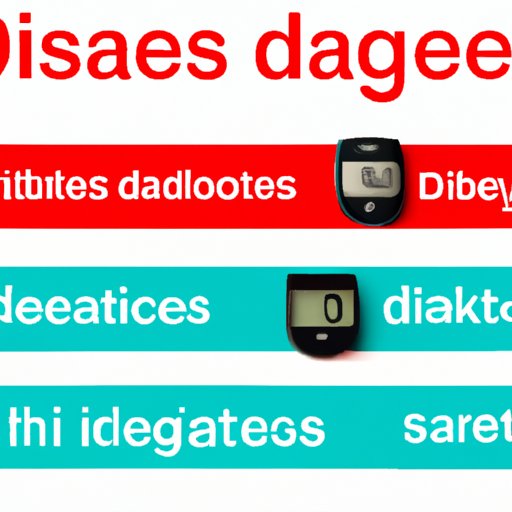I. Introduction
Diabetes is a chronic condition that affects millions of people worldwide. In the United States alone, over 34 million people have diabetes, and an estimated 88 million have pre-diabetes, which puts them at high risk of developing diabetes. In this article, we will explore how to know if you have diabetes so you can identify the condition early and take steps to manage it.
II. Symptoms to Look Out For
The symptoms of diabetes can vary depending on the type of diabetes, but some common signs to look out for include excessive thirst or hunger, frequent urination, blurred vision, slow-healing wounds, fatigue, and tingling or numbness in the hands or feet. These symptoms occur when the body’s glucose levels are too high, and the body is unable to process all the sugar in the bloodstream.
If you are experiencing any of these symptoms, it’s important to get a professional evaluation. While these symptoms could be indicative of other illnesses, they also signal the onset of diabetes, and early detection can help prevent complications.
III. Risk Factors
Some common risk factors for developing diabetes include obesity, a sedentary lifestyle, poor diet, family history, age, and gestational diabetes. Your age, genetics, and ethnic background can also affect your likelihood of developing diabetes.
Obesity is a leading risk factor for Type 2 diabetes, and the number of people with obesity continues to grow worldwide. Over a third of adults in the US are obese, which puts them at high risk for developing diabetes. Sedentary lifestyles and poor diet choices also increase the likelihood of developing diabetes.
According to the CDC, people over the age of 45 are at increased risk of developing diabetes, and African Americans, Hispanic/Latino Americans, American Indians, and Pacific Islanders have higher rates of diabetes than Caucasians.
IV. Medical Tests to Consider
The most common medical tests used to detect diabetes include a fasting plasma glucose test, a random plasma glucose test, and an oral glucose tolerance test. Your healthcare provider may also perform a hemoglobin A1C test to evaluate your average glucose levels over the past 2-3 months. Urine tests can also help diagnose diabetes.
During a glucose tolerance test, your healthcare provider will monitor your blood sugar levels after you drink a sugary beverage. If your blood sugar levels remain high after this test, you may have diabetes. Consult your medical team to interpret the results of these tests and what they mean for your management of diabetes.
V. How to Monitor Your Blood Sugar
Monitoring your blood sugar levels is important when managing diabetes. To do this, people often use a glucose meter or a continuous glucose monitor. Different tools may appeal to different people, but the idea is to measure your glucose level at least twice daily to maintain adequate control.
Having healthy blood sugar levels can positively impact other aspects of your health, like kidney function and nerve sensitivity. A healthy limit for blood glucose readings is between 70-180 mg/dL. Keeping a logbook of your blood sugar levels and food intake can help detect patterns and areas for improvement in your self-management of diabetes.
VI. How to Make Dietary Changes
One of the easiest and most impactful ways to manage diabetes is to make changes to your diet. Eating a balanced diet with protein and fiber, in the forms of whole grains and vegetables, can help manage sustained energy and blood sugar levels. Stick with lean protein like poultry and seafood, and avoid sugary drinks and refined carbohydrates.
It’s also essential to portion meals and plan meals ahead of time. Set small goals when making dietary changes, and make your changes sustainable and long-term.
VII. Importance of Exercise
Leading an active lifestyle can also contribute positively to managing diabetes. Exercise can increase insulin sensitivity, allowing your body to use glucose more effectively. Incorporate different forms of physical activity into your routine like strength training, aerobic exercise, and stretching, as each form offers unique health benefits.
You don’t need to be a fitness enthusiast to make the most of exercise for diabetes management. Small movements, like taking a leisurely walk around the neighborhood or doing gentle yoga can also contribute positively to glucose levels.
VIII. When to See a Medical Professional
If you have symptoms of diabetes, it’s crucial to get an official diagnosis and then start the journey to manage your condition. In general, it’s important to talk to a doctor if you are experiencing sustained symptoms of uncontrollable glucose level and fatigue.
Your healthcare provider can help identify the best treatment for you, which may include medication, lifestyle adjustments, or a combination of both. Monitoring and regulating blood sugar levels with consistent healthy behaviors such as diet and exercise are also important to managing diabetes.
IX. Conclusion
Diabetes is a chronic condition that requires ongoing management and attention. Learning how to detect diabetes is the first step in your journey with this condition. Early and attentive management of the symptoms can help alleviate or prevent complications.
As we have mentioned, keeping a logbook of your health and medical regimen can help you identify patterns and take proactive steps to manage your diabetes.
Make sure to reduce your risk factors by addressing controllable factors like diet, exercise, and maintaining a healthy weight. If you do have diabetes, lifestyle modifications can also potentially help you reverse it or at least reduce the risk of further complications.
Consult a healthcare provider and be proactive with your health management.
